The iPad Air Review
by Anand Lal Shimpi on October 29, 2013 9:00 PM ESTGPU Performance
Since the iPad Air uses the same A7 silicon as the iPhone 5s, it also uses the same on-die GPU as the 5s: IMG’s PowerVR G6430. This is a 4-cluster configuration of IMG’s latest graphics hardware, running at some relatively high frequency. I already went into some detail on the G6430 in our 5s review so I won’t rehash that here, but we’re basically looking at a shift to a more efficient scalar architecture.
I still don’t have confirmations of clock speeds, but I believe we’re looking at a max GPU clock of around 450MHz. As you’ll see from the results below, there’s a small difference in performance between the iPad Air and iPhone 5s in terms of peak GPU performance - implying very similar clocks. The difference is the iPad Air should be able to sustain its max frequency longer than the iPhone 5s can.
| Mobile SoC GPU Comparison | ||||||||||||
| PowerVR SGX 554MP4 | PowerVR G6430 | PowerVR G6430 | ||||||||||
| Used In | iPad 4 | iPhone 5s | iPad Air | |||||||||
| SIMD Name | USSE2 | USC | USC | |||||||||
| # of SIMDs | 32 | 4 | 4 | |||||||||
| MADs per SIMD | 4 | 32 | 32 | |||||||||
| Total MADs | 128 | 128 | 128 | |||||||||
| GFLOPS @ 300MHz | 76.8 GFLOPS | 76.8 GFLOPS | 76.8 GFLOPS | |||||||||
| GFLOPS as Shipping | 68.1 GFLOPS (?) | 115.2 GFLOPS | 115.2 GFLOPS | |||||||||
Since we’re talking about an A7 here and not an X-series SoC, there’s still only a 64-bit wide memory interface. As memory bandwidth is a key enabler of GPU performance I was curious to see how GPU performance compared to the outgoing iPad 4 with its much wider memory interface. Do keep in mind that the A7 does include a large system cache on-die, which can help improve effective memory bandwidth.
GFXBench 2.7
We'll start our GPU performance analysis with a look at low level results using GFXBench/GLBenchmark 2.7. The low level tests, particularly the offscreen ones, should give us some idea as to whether or not there's any increase in GPU frequency for the iPad Air vs. iPhone 5s implementations of A7.
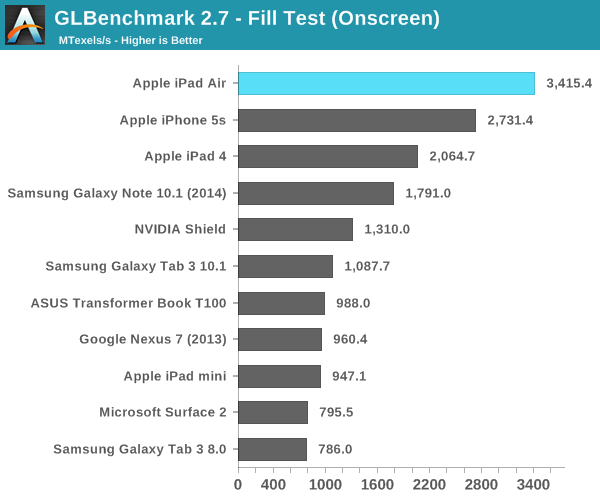
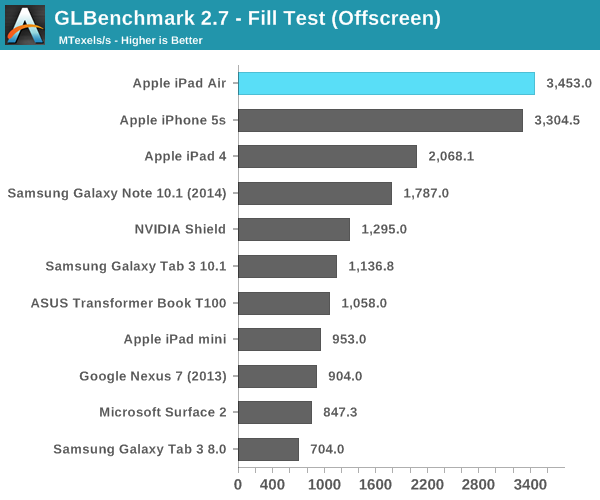
Looking at the fill rate results, there's a 4.5% increase in performance compared to the iPhone 5s. That could be the magnitude of clock increase that we're seeing between A7s. Apple could very well be relying on more thermal headroom in the iPad Air to provide any real world GPU performance advantages over the iPhone 5s.
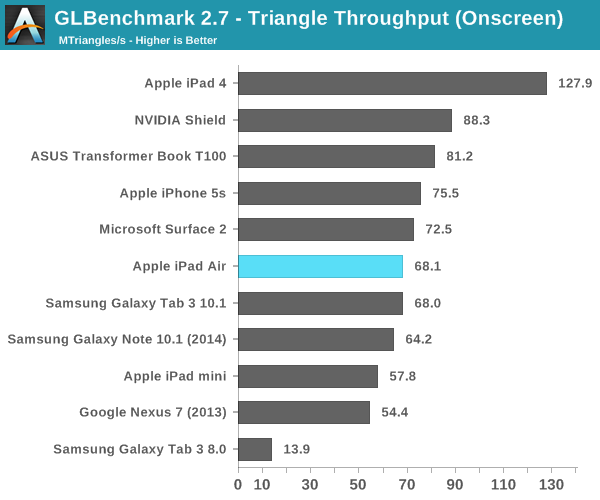

We see an even smaller gap between the Air and 5s in the triangle throughput tests (2.9%). There doesn't seem to be any substantial difference in GPU frequency between A7 implementations here. The regression in triangle rate performance compared to the iPad 4 is explained by differences in how Series 6 and Series 5XT GPUs scale in width. Whereas 5XT replicated nearly the entire GPU for "multi-core" versions, multi-cluster versions of Rogue only replicate at the shader array. The result? We don't see the same sort of peak triangle setup scaling we did back on multi-core 5XT parts. I'm not sure I'm particularly happy with the magnitude of the regression here, but I haven't seen any real world cases where it matters yet.
Next up are the game simulation tests. We'll start with the more strenuous of the two: T-Rex HD.
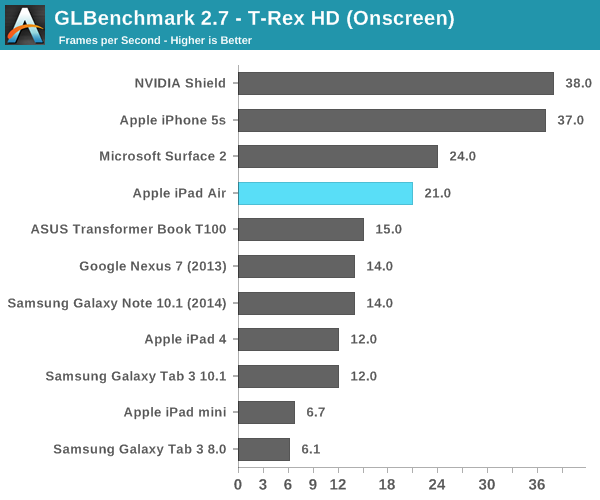
Here we get closer to Apple's claims of a 2x increase in performance. The iPad Air delivers 75% more performance than the iPad 4 in this test. Once again the iPhone 5s pulls ahead but that's because the onscreen tests render at display resolution, which is lower on the 5s.
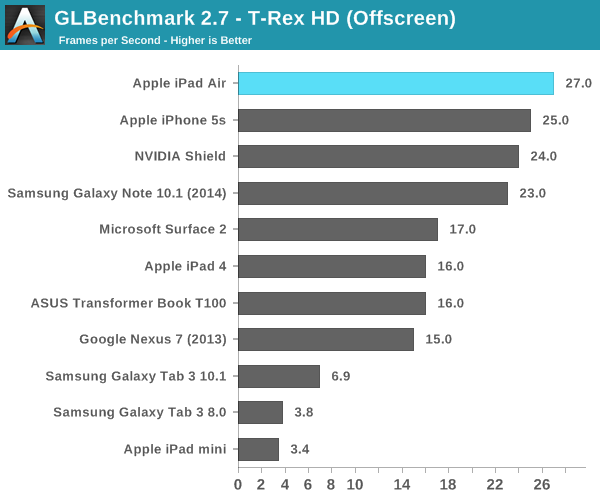
Offscreen performance sees similar scaling: ~69% better performance compared to the iPad 4.
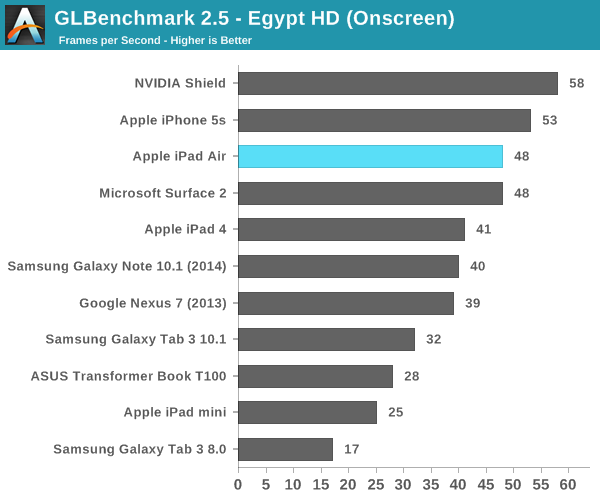
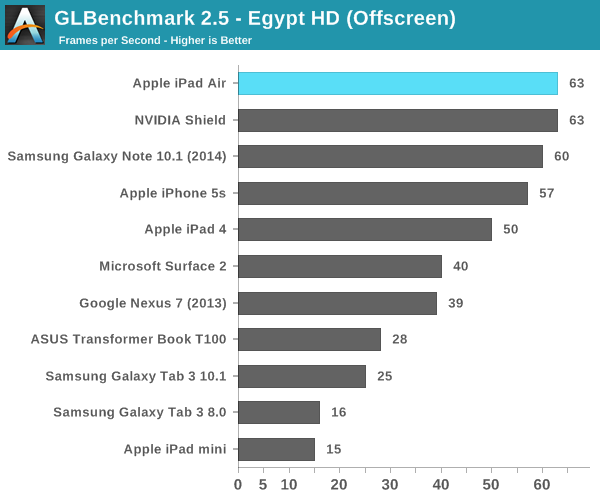
3DMark
We're once again running 3DMark's newest Unlimited mode which does its best to run independently of v-sync and at a standard resolution across all devices. I've also included 3DMark Extreme results below that feature a few more comparison points.
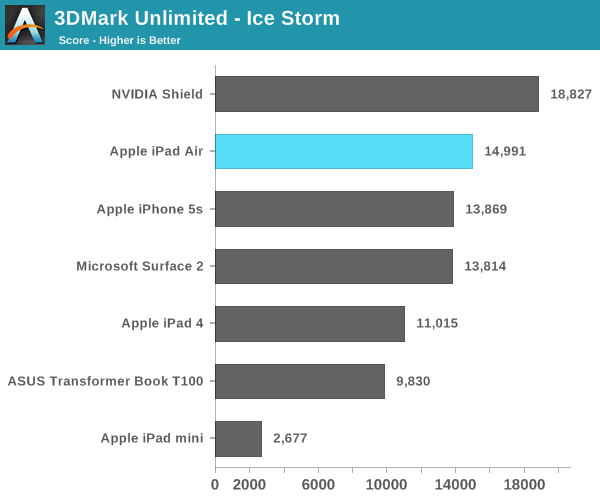
The overall Ice Storm scores show a 36% improvement in performance over the iPad 4 and an 8% increase compared to the iPhone 5s. Given the CPU frequency advantage of the A7 in the Air vs. the iPhone 5s, I'm guessing that's why we're seeing the performance gap we are here.
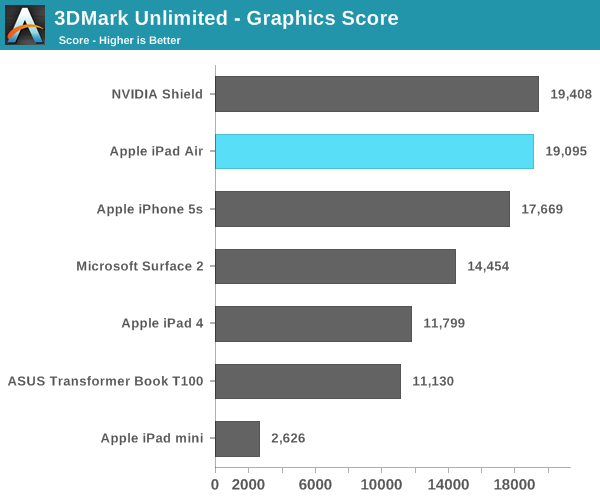
If we focus exclusively on the GPU tests (which themselves are still CPU bound), the iPad Air's performance advantage over the iPad 4 grows to over 60%.
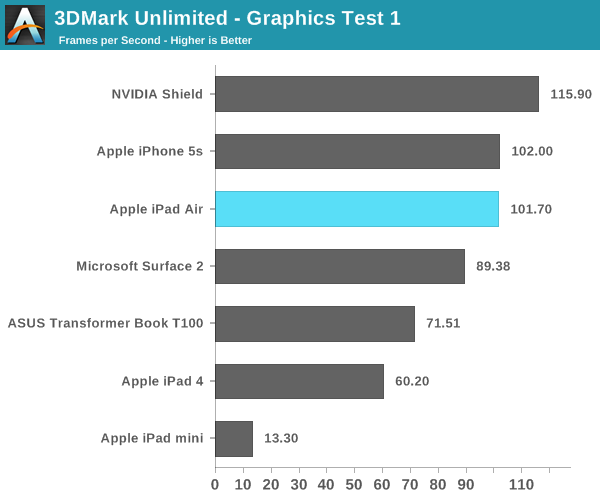
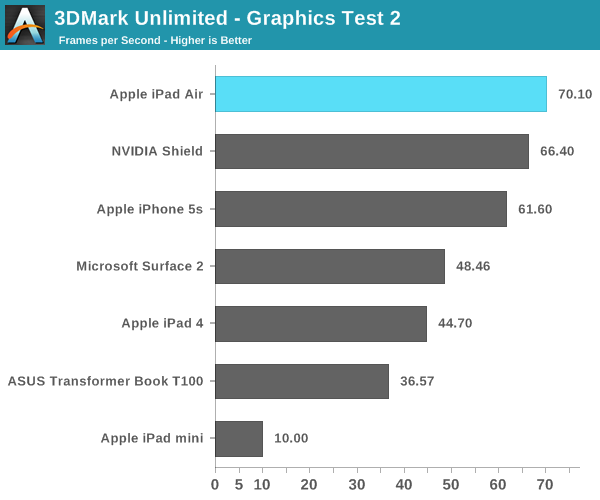
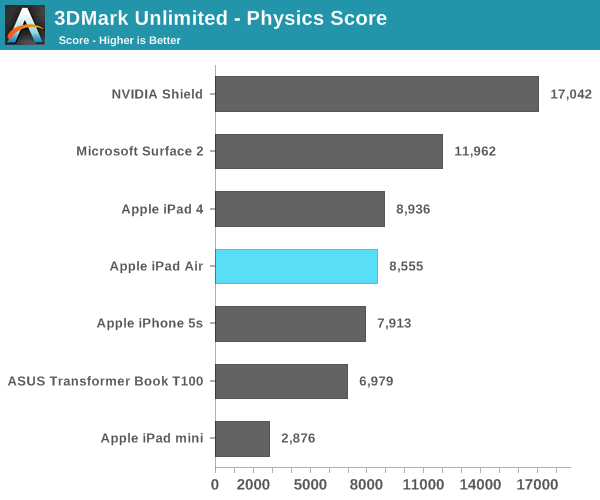
I'm still not entirely sure what's going on with the 3DMark Physics test, but we've seen this two reviews in a row now where Cyclone showed no performance increase at all compared to Swift despite this being largely a CPU test.
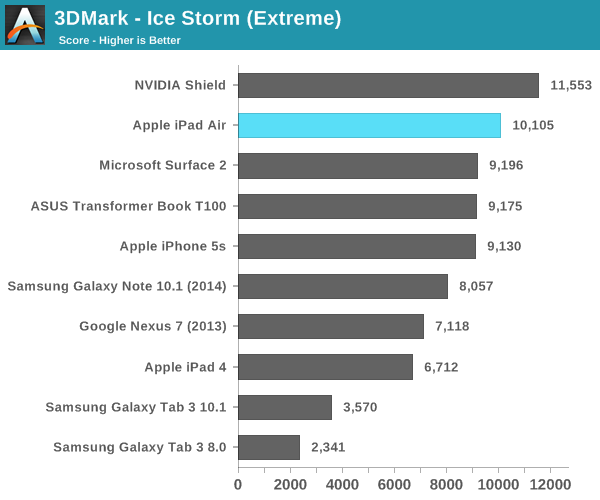
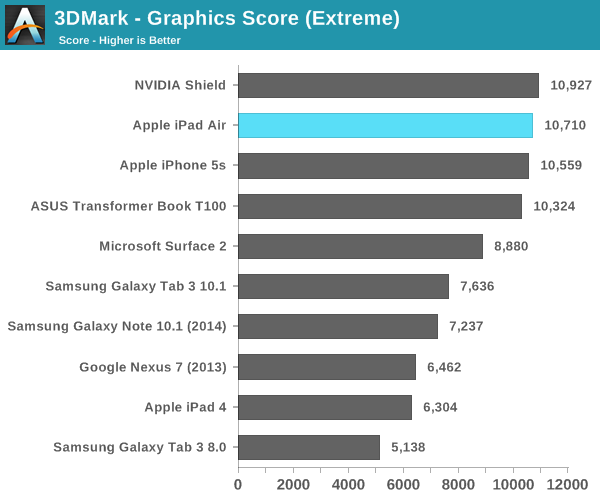
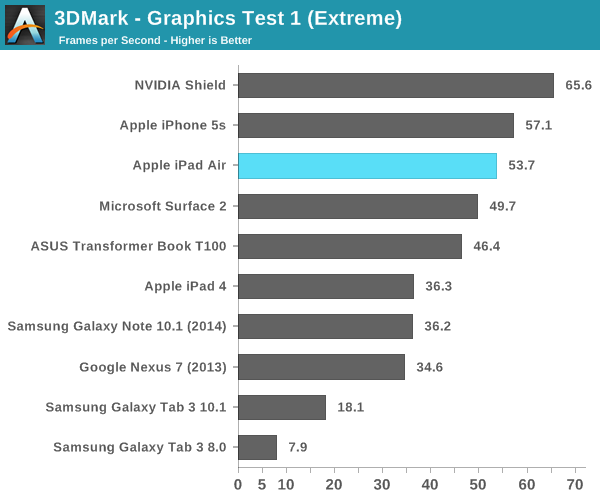
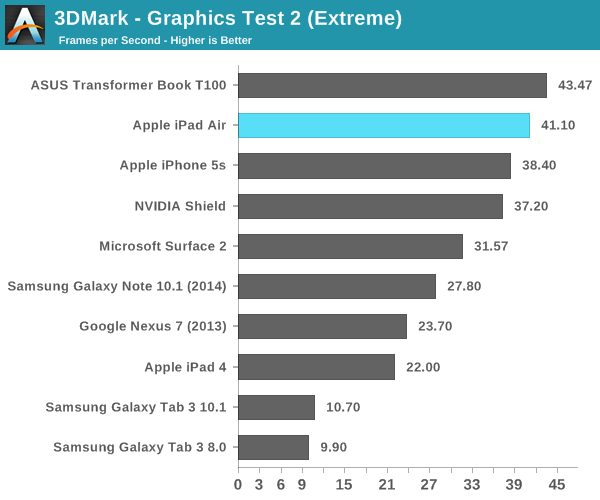

Basemark X
Basemark X is a new addition to our mobile GPU benchmark suite. There are no low level tests here, just some game simulation tests run at both onscreen (device resolution) and offscreen (1080p, no vsync) settings. The scene complexity is far closer to GLBenchmark 2.7 than the new 3DMark Ice Storm benchmark, so frame rates are pretty low.
I'm still having random issues with Basemark X reliably running both on and offscreen tests on iOS 7. Unfortunately I could only get onscreen results for the iPad Air, which came in at 46% faster than the iPad 4. Note the iPad mini and iPhone 5s benefit from having lower native resolutions here, which is why they perform so well.
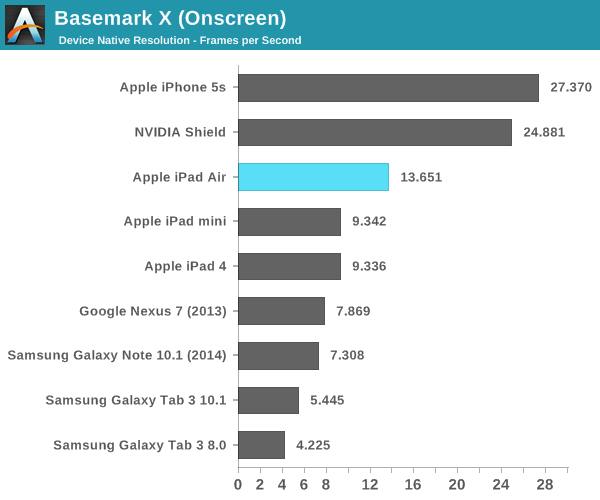










444 Comments
View All Comments
doobydoo - Friday, November 15, 2013 - link
The hardware in the HDX is slower, and it is finished in plastic. So which part was inaccurate?melgross - Wednesday, October 30, 2013 - link
There is no such thing as 100% RGB gamut. Which gamut are you talking about? sRGB? Adobe 1998 RGB? Pro RGB? There are a lot of RGB standards out there.Theard - Wednesday, October 30, 2013 - link
what Cindy implied I didn't even know that people can earn $6894 in four weeks on the computer. look at this site ... jobs23.comLizbeth - Sunday, November 3, 2013 - link
and is several price points less that the ipad airKrysto - Wednesday, October 30, 2013 - link
> is probably the higher clocked Z3770I don't see that in any tablets today, let alone smartphones. So don't say it like that, as if it's already happened. As it is, Intel's chips aren't very competitive, in both CPU and GPU performance.
> while Qualcomm will probably pass Apple's GPU early next year.
They are equal right now, at least in smartphones. The others, perhaps with the exception of Nvidia, don't really make separate "tablet chips". They make one chip for both smartphones and tablets.
Speedfriend - Wednesday, October 30, 2013 - link
"As it is, Intel's chips aren't very competitive, in both CPU"You obviously have a problem reading, given the Transformer T100 which is very close to the iPhone 5S and iPad Air in the benchmarks above, uses the Atom Z3740, which is only the second fastest. So the Z3770, which is clocked 33% higher, should be at least equal if not better than A7 in CPU benchmarks.
How in your mind that equates to not competitive I don't know..
Homeles - Wednesday, October 30, 2013 - link
Not to mention that a lot of A7's strength isn't in the silicon, it's in the software stack on top of it. All of the CPU benchmarks are done through the stock web browser -- that's something Apple can fine tune, while Intel cannot. Therefore, the A7 outperforming Atom doesn't point to Atom being weaker at a silicon level, and instead shows the advantages of being able to hand tune your OS and applications and squeeze more out of your hardware.raptorious - Wednesday, October 30, 2013 - link
I'll give you one reason: the fact that Anand omitted the iPad 4 from the latency graph in the "An Update on Apple’s A7: It's Better Than I Thought" page. Why is the iPad 4 in the bandwidth graph and not in the latency graph. I'll tell you why: because the iPad 4 has better latency and Anand doesn't want to make the A7 look bad, so he left it out. No bias? Right.syedjalalt - Tuesday, November 5, 2013 - link
Apple iPad is a great product. No doubt. The word selection for writing such important reviews has been good here. IF you go The Verge and see the iPad review, you will notice how biased and predictable they have become. Nilay Patel doesn't know anything. The guys @verge always mock Android and especially Samsung.Last year's Nexus 4's review score had 8 for camera and 9 for ecosystem(as far as I remember). This year, ecosystem is 8 and camera is 5. Great!!!1
doobydoo - Friday, November 15, 2013 - link
Yep it's ridiculous that the Nexus 4 got 8 for camera. Should have been 3/4.Ecosystem scores can vary over time so don't see the problem there. Android hasn't moved on much in the past year.